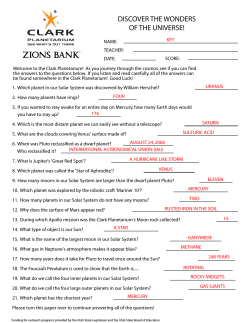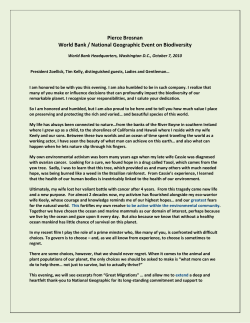
M Stars as JWST targets
Funding provided by NSF GRFP awarded to CD & NASA Kepler PSP awarded to DC M Dwarfs as Targets for JWST Courtney Dressing & David Charbonneau Harvard-Smithsonian Center for Astrophysics JWST Transit Planning Meeting March 12, 2014 Image credit: ESO/L. Calçada Motivation • M dwarfs are plentiful, nearby, and small Methodology Generate stellar sample Assign planets to stars based on Kepler occurrence rates Query properties of the transiting planet host stars Assess detectability & plan for JWST observations (rest of this meeting) Step 1: Construct Stellar Sample MEarth +60 +30 14h 16h 18h 20h 22h 0 2h 4h 6h 8h 10h Number of Stars (Cumulative) -30 -60 Dittmann et al. 2013 MEarth telescopes in Arizona Distance (pc) Step 1: Construct Stellar Sample MEarth Lepine +60 +30 14h 16h 18h 20h 22h 0 2h 4h 6h 8h -30 Incorporate additional stars within 33pc -60 from Lepine 2005 10h Step 1: Construct Stellar Sample MEarth Lepine +60 HIP +30 14h 16h 18h 20h 22h 2h 0 4h 6h 8h 10h -30 -60 Hipparcos Main Catalog (Perryman et al. 1997) Step 1: Construct Stellar Sample MEarth Lepine +60 HIP YPC +30 14h 16h 18h 20h 22h 0 2h 4h 6h 8h 10h -30 -60 Yale Parallax Catalog (van Altena et al. 1995) Step 1: Construct Stellar Sample MEarth (548) MEarth Copy (548) Lepine (322) Lepine Copy (322) HIP (392) YPC (90) +60 +30 14h 16h 18h 20h 22h 0 2h 4h 6h 8h 10h -30 -60 Correct for incompleteness in the southern sky. Step 2: Estimate Planet Occurrence Rate 4 Planet Radius (REarth) 3 2 1 d2n/(dlogR dlogP) 1 0.0 1.0 2.0 3.0 10 Period (Days) 100 Analytic expression from Berta et al. 2013 (based on Dressing & Charbonneau 2013) Step 3: Host Star Properties 400 Transiting Planets (79) Transiting Small HZ (8) Stars within 20pc (2222) 300 10 200 5 100 0 0.0 0.1 0.2 0.3 0.4 Host Star Mass (M Sun) 0.5 0 0.6 Number of Stars Number of Transiting Planets 15 Step 3: Host Star Properties 300 Transiting Planets (79) Transiting Small HZ (8) Stars within 20pc (2222) 10 250 200 150 5 100 50 0 0 4 6 8 Host Star K 10 12 Number of Stars Number of Transiting Planets 15 Step 3: Host Star Properties 250 Transiting Planets (79) Transiting Small HZ (8) Stars within 20pc (2222) 200 10 150 100 5 50 0 4 6 8 10 Host Star J 12 0 14 Number of Stars Number of Transiting Planets 15 Implications All Transiting Small HZ Transiting Number within 20 pc 79 (-5/+6) 8.1 (-3.1/+2.9) Distance to closest (pc) 2.5 (-0.5/+2.4) 9.1 (-3.7/+3.5) Brightest in J 4.2 (-0.5/+1.2) 6.3 (-0.8/+0.9) Brightest in K 3.3 (-0.5/+1.4) 5.5 (-0.9/+0.9) The most probable distance to the nearest transiting Earth-size planet in the habitable zone is 9 pc. Detectability: Planet with HydrogenRich Atmosphere around 0.2 M Star Batalha et al. 2013 Detectability: Planet with HydrogenPoor Atmosphere around 0.2 M Star Batalha et al. 2013 Revisiting the Stellar Sample • Compiled list of nearby stars – – – – – Northern Stars Proper Motion Catalog (Lepine & Shara 2005) Northern stars within 33 pc (Lepine 2005) MEarth Trigonometric Parallax sample (Dittmann et al. 2013) Hipparcos Catalog (Perryman et al. 1997) Yale Parallax Catalog (van Altena et al. 1995) • Areas for improvement – Census of southern M dwarfs – Northern M dwarf sample incomplete beyond 25 pc • Future steps – Use catalogs compiled for TESS & K2 target selection – Incorporate GAIA distance estimates Ongoing Work: Updating the Planet Occurrence Rate Estimate • • • • • Measuring the detection threshold for M dwarfs Searching for additional planets in Q1-Q16 data Inspecting high-resolution follow-up images Checking for centroid shifts Comparing periods & ephemerides to known planets & EBs • Incorporating false positive correction • End Goals: Update planet properties & revise planet occurrence rate Stellar Effective Temperature (K) Updated Estimate Using Q1-12 Data & New HZ Boundaries 4000 3800 3600 3400 3200 1 HZ: Kopparapu et al. 2013, ApJ 765: 131 10 Period (Days) 100 Stellar Models: Dotter et al. 2008, ApJS, 178, 89 Stellar Effective Temperature (K) Updated Estimate Using Q1-12 Data & New HZ Boundaries 4000 3800 0.56 (+0.32/-0.13) 0.5-1.4 REarth Planets per HZ (See also Kopparapu 2013, Gaidos et al. 2013) 3600 3400 RP < 1.4 R E 1.4 < RP < 2.0 R E RP > 2.0 R E 3200 1 HZ: Kopparapu et al. 2013, ApJ 765: 131 10 Period (Days) 100 Planet Candidates: Q1-Q12 KOI List Stellar Models: Dotter et al. 2008, ApJS, 178, 89 Number of Earths per HZ Paper Eta Earth HZ Inner Edge HZ Outer Edge Planet Properties Bonfils+ 2013 0.41 Recent Venus Early Mars (Selsis+2007) (Selsis+ 2007) 50% Clouds 50% Clouds 1 < m sin I < 10 MEarth RP > 0.8 REarth (Selsis+ 2007) (Selsis+ 2007) (+0.54/-0.13) Gaidos 2013 0.46 (+0.18/-0.15) Kopparapu 2013 (Conservative) Kopparapu 2013 (Optimistic) Dressing & Charbonneau 0.48 (+0.12/-0.24) 0.61 (+0.07/-0.15) 0.15 (+0.13/-0.06) Moist Greenhouse Max Greenhouse 0.5 < RP < 1.4 (Kopparapu+ 2013) (Kopparapu+ 2013) REarth Recent Venus (Kopparapu+ 2013) Water Loss (Kasting+ 1993) Early Mars 0.5 < RP < 2 (Kopparapu+ 2013) REarth CO2 Condensation 0.5 < RP < 1.4 (Kasting+ 1993) REarth 2013 Dressing & Charbonneau 0.56 (+0.32/-0.13) Moist Greenhouse Max Greenhouse 0.5 < RP < 1.4 (Kopparapu+ 2013) (Kopparapu+ 2013) REarth (in prep) Dressing & Charbonneau (in prep) 0.66 (+0.25/-0.12) Moist Greenhouse Max Greenhouse 0.5 < RP < 1.4 (Kopparapu+ 2013) with Clouds REarth (Yang+ 2013) Planet Detection Pipeline Detrend & clean Kepler light curves Generate Box-fitting Least Squares power spectrum for each star (Scott Fleming’s Fortran implementation of Kovacs et al. 2002) Identify highest peaks & fit simple transit models Excise data near accepted transits Repeat until no new signals are detected We Recover Most Known KOIs Planet Radius (REarth) 10 Accepted Detected Not Detected 1 1 10 Period (Days) 100 Transit Injection & Recovery KID8753991: Recovery Fraction 3.0 0% 50% 100% Planet Radius (REarth) 2.5 2.0 1.5 1.0 0.5 1 10 Period (Days) 100 Implications All Transiting Small HZ Transiting Number within 20 pc 79 (-5/+6) 8.1 (-3.1/+2.9) Distance to closest (pc) 2.5 (-0.5/+2.4) 9.1 (-3.7/+3.5) Brightest in J 4.2 (-0.5/+1.2) 6.3 (-0.8/+0.9) Brightest in K 3.3 (-0.5/+1.4) 5.5 (-0.9/+0.9) The most probable distance to the nearest transiting Earth-size planet in the habitable zone is 9 pc. ADDITIONAL SLIDES MEarth Results are Consistent with Occurrence Rates from Kepler • 8 16” telescopes • Mount Hopkins, AZ • 2008 - present Photo: J. Irwin MEarth Team MEarth Sensitivity GJ1214b Planet Equilibrium Temperature Zachory K. Berta-Thompson Elisabeth Newton Kepler Occurrence Rate GJ1214b Planet Equilibrium Temperature Planet Size (Earth Radii) Jason Dittmann Emilio Falco Planet Size (Earth Radii) Planet Size (Earth Radii) David Charbonneau (PI) Jonathan Irwin Estimated Planet Yield GJ1214b Planet Equilibrium Temperature Berta et al. 2013, ApJ, 775, 91 Stellar Effective Temperature (K) Updated Estimate Using Q1-12 Data & Kopparapu et al. 2013 HZ Boundaries 0.56 (+0.32/-0.13) 4000 2992.01 0.5-1.4 REarth Planets per HZ (See also Kopparapu 2013, Gaidos et al. 2013) 4087.01 3800 571.05 2418.01 3263.01 854.01 3600 3400 1686.01 RP < 1.4 R E 1.4 < RP < 2.0 R E RP > 2.0 R E 3200 1 HZ: Kopparapu et al. 2013, ApJ 765: 131 10 Period (Days) 100 Planet Candidates: Q1-Q12 KOI List Stellar Models: Dotter et al. 2008, ApJS, 178, 89 D+C 2013: M Dwarf Planet Occurrence Estimate using Q1-Q6 Data 0.15 (+0.13/-0.06) Earth-size planets per HZ Dressing & Charbonneau 2013, ApJ, 767, 95 Follow-Up Images of Potentially Habitable KOIs 1” KOI 2626 Keck Ciardi KOI 1422 0.74” HST Gilliland Follow-Up Images of Potentially Habitable KOIs 1” KOI 571 AstraLux Lillobox 2” KOI 2418 Keck Ciardi 0.7” 1” KOI 854 KOI 1686 HST Gilliland HST Gilliland KOI 4087 Keck Ciardi 1” All images from the Kepler Community Follow-up Observing Program (CFOP) website
© Copyright 2025












